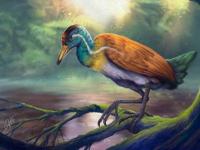Meet Mystriosaurus laurillardi, Marine Crocodile from Jurassic Period

An incomplete crocodile skull found near the city of Altdorf in Bavaria, southern Germany, in the 1770s has been recognized as Mystriosaurus laurillardi, which lived in tropical waters during the Jurassic period.
“Mystriosaurus laurillardi is one of the first marine crocodile fossils ever to be described,” said lead author Dr. Sven Sachs, a paleontologist at the Naturkunde-Museum Bielefeld.
“While it received its generic name in 1834, the 3D preserved skull was mentioned in the literature as early as 1776.”
“The fossil that would later be named Mystriosaurus laurillardi was found in a quarry in Altdorf near Nuremberg in southern Germany by Johann Friedrich Bauder.”
Mystriosaurus laurillardi was more than 13 feet (4 m) in length, had a long snout and pointed teeth, and preyed on fish.
The prehistoric predator lived around 180 million years ago in warm Jurassic seas alongside other animals including ammonites and ichthyosaurs.
“Mystriosaurus laurillardi looked like a gharial but it had a shorter snout with its nasal opening facing forwards, whereas in nearly all other fossil and living crocodiles the nasal opening is placed on top of the snout,” Dr. Sachs noted.

For the past 60 years, it was thought the animal was part of a similar species, known as Steneosaurus bollensis, which existed around the same time.
“Mystriosaurus laurillardi has been broadly accepted as a valid genus in numerous publications during the 19th and early 20th centuries,” Dr. Sachs explained.
“However, in the 1960s, Tübingen paleontologist Frank Westphal published two revisions of Early Jurassic teleosauroids and concluded that Mystriosaurus laurillardi was in fact a subjective junior synonym of Steneosaurus bollensis.”
Dr. Sachs and his team analyzed the new fossils unearthed in the UK and Germany and concluded that Mystriosaurus laurillardi is in fact a distinct species.
They also revealed that another skull, discovered in Yorkshire in the 1800s, belongs to Mystriosaurus laurillardi.
“The discovery of fossils in present-day Germany and the UK shows that the species could easily swim between islands, much like modern saltwater crocodiles,” they said.
“Unraveling the complex history and anatomy of fossils like Mystriosaurus laurillardi is necessary if we are to understand the diversification of crocodiles during the Jurassic,” said co-author Dr. Mark Young, a researcher in the School of GeoSciences at the University of Edinburgh.
“Their rapid increase in biodiversity between 200 and 180 million years ago is still poorly understood.”
The study was published in the journal Acta Palaeontologica Polonica.
_____
Sven Sachs et al. 2019. The mystery of Mystriosaurus: Redescribing the poorly known Early Jurassic teleosauroid thalattosuchians Mystriosaurus laurillardi and Steneosaurus brevior. Acta Palaeontologica Polonica 64 (3): 565-579; doi: 10.4202/app.00557.2018
Source: www.sci-news.com








